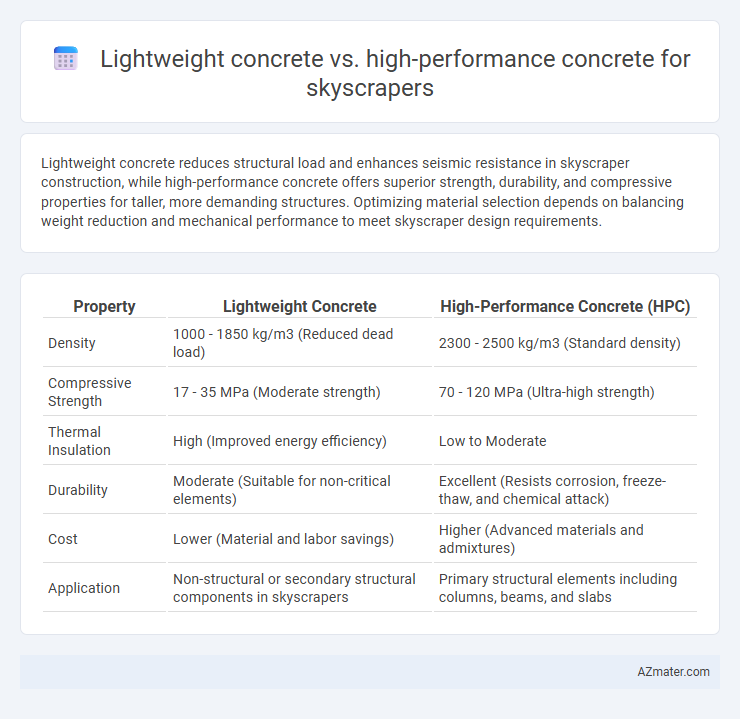Lightweight concrete reduces structural load and enhances seismic resistance in skyscraper construction, while high-performance concrete offers superior strength, durability, and compressive properties for taller, more demanding structures. Optimizing material selection depends on balancing weight reduction and mechanical performance to meet skyscraper design requirements.
Table of Comparison
| Property | Lightweight Concrete | High-Performance Concrete (HPC) |
|---|---|---|
| Density | 1000 - 1850 kg/m3 (Reduced dead load) | 2300 - 2500 kg/m3 (Standard density) |
| Compressive Strength | 17 - 35 MPa (Moderate strength) | 70 - 120 MPa (Ultra-high strength) |
| Thermal Insulation | High (Improved energy efficiency) | Low to Moderate |
| Durability | Moderate (Suitable for non-critical elements) | Excellent (Resists corrosion, freeze-thaw, and chemical attack) |
| Cost | Lower (Material and labor savings) | Higher (Advanced materials and admixtures) |
| Application | Non-structural or secondary structural components in skyscrapers | Primary structural elements including columns, beams, and slabs |
Introduction to Concrete Types for Skyscrapers
Lightweight concrete, featuring lower density and enhanced thermal insulation, reduces the overall structural load of skyscrapers, improving seismic performance and foundation efficiency. High-performance concrete offers superior strength, durability, and workability, enabling thinner structural elements and longer spans essential for tall building design. Selecting between these concretes depends on balancing load reduction with strength demands and long-term durability in skyscraper construction.
Defining Lightweight Concrete
Lightweight concrete for skyscrapers is characterized by its reduced density, typically ranging from 1,440 to 1,840 kg/m3, achieved by incorporating lightweight aggregates such as expanded clay, shale, or pumice. This reduction in weight enhances structural efficiency, decreases dead load, and improves seismic resistance compared to conventional or high-performance concrete, which prioritizes strength and durability with densities closer to 2,400 kg/m3. The choice of lightweight concrete directly impacts the design of skyscraper frameworks by optimizing load distribution and material usage while maintaining adequate compressive strength, often between 17 to 35 MPa.
Understanding High-Performance Concrete
High-performance concrete (HPC) offers superior strength, durability, and enhanced resistance to environmental stressors compared to lightweight concrete, making it ideal for skyscraper construction where structural integrity and longevity are critical. HPC typically features optimized mix designs with low water-to-cement ratios, advanced admixtures, and supplementary cementitious materials like silica fume to achieve compressive strengths exceeding 80 MPa. Its enhanced mechanical properties and durability enable thinner structural elements and high load-bearing capacity, essential for the demanding vertical loads and dynamic forces encountered in tall buildings.
Key Differences in Material Composition
Lightweight concrete for skyscrapers incorporates aggregates such as expanded clay, shale, or slate, resulting in reduced density and improved thermal insulation compared to conventional materials. High-performance concrete features a refined mix design with supplementary cementitious materials like silica fume and fly ash, achieving superior strength, durability, and reduced permeability. The key difference lies in lightweight concrete prioritizing weight reduction through aggregate selection, while high-performance concrete focuses on enhanced mechanical properties via optimized binder and admixture combinations.
Structural Strength and Load-Bearing Capacity
Lightweight concrete offers reduced density, which decreases the overall load on skyscraper foundations, making it advantageous for minimizing seismic forces without significantly compromising structural strength. High-performance concrete provides superior compressive strength and durability, enabling skyscrapers to bear heavier loads and withstand extreme stress conditions. Selecting between lightweight and high-performance concrete depends on balancing the need for reduced self-weight against the demand for maximum load-bearing capacity in high-rise construction.
Installation and Construction Techniques
Lightweight concrete offers ease of handling and faster installation due to its reduced density, making it ideal for high-rise construction where lowering dead load is critical. High-performance concrete provides superior strength and durability but requires meticulous batching, curing, and specialized formwork to ensure optimal performance in skyscraper applications. Both types demand precise construction techniques, yet lightweight concrete facilitates quicker assembly, while high-performance concrete enhances structural integrity under extreme loads.
Thermal and Acoustic Insulation Properties
Lightweight concrete, characterized by its lower density and inclusion of insulating aggregates such as expanded clay or perlite, offers superior thermal insulation properties, reducing heat transfer in skyscraper walls and improving energy efficiency. High-performance concrete, while denser and stronger, provides enhanced acoustic insulation due to its mass and compactness, effectively dampening urban noise pollution in tall buildings. Choosing between lightweight and high-performance concrete depends on balancing thermal insulation needs to lower HVAC loads versus acoustic insulation requirements for occupant comfort in skyscraper design.
Long-Term Durability and Maintenance
Lightweight concrete offers reduced structural load and enhanced thermal insulation, but may require more frequent inspections and maintenance due to potential lower long-term durability compared to high-performance concrete (HPC). High-performance concrete, with its dense microstructure and superior compressive strength, delivers exceptional resistance to environmental degradation, chemical attack, and freeze-thaw cycles, ensuring lower maintenance costs and extended lifespan for skyscraper applications. Selecting HPC for critical load-bearing components improves long-term structural integrity, minimizing repair interventions and lifecycle expenses over decades.
Environmental Impact and Sustainability
Lightweight concrete reduces the overall mass of skyscrapers, leading to lower foundation loads and decreased material consumption, which significantly cuts carbon emissions during construction. High-performance concrete enhances durability and extends the lifespan of structures, minimizing repair frequency and resource use over time. Incorporating recycled aggregates and industrial byproducts in both types further optimizes sustainability by reducing waste and reliance on virgin materials.
Cost Implications and Project Suitability
Lightweight concrete reduces overall structural weight, potentially lowering foundation costs but typically entails higher material expenses compared to traditional mixes, making it cost-effective for skyscrapers with stringent load requirements. High-performance concrete offers superior strength and durability, justifying its higher initial cost through enhanced longevity and reduced maintenance, ideal for skyscrapers exposed to harsh environmental conditions. Project suitability depends on balancing structural demands and budget constraints; lightweight concrete benefits designs prioritizing weight reduction, while high-performance concrete suits projects requiring extreme strength and resilience.

Infographic: Lightweight concrete vs High-performance concrete for Skyscraper
 azmater.com
azmater.com